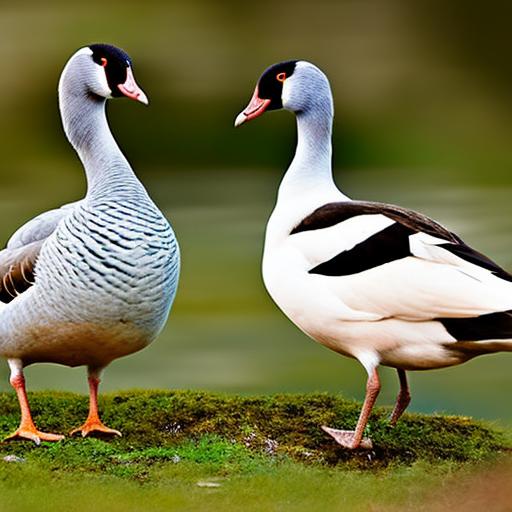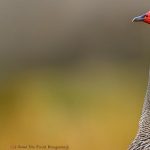Tufted Roman Geese are a breed of domestic geese that have a long and fascinating history. They are believed to have originated in ancient Rome and were highly prized for their meat and eggs. Today, they are still a popular breed among farmers and hobbyists due to their unique characteristics and benefits.
The history of Tufted Roman Geese can be traced back to ancient Rome, where they were bred for their meat and eggs. They were highly valued for their large size, tender meat, and high egg production. Over the centuries, they spread throughout Europe and eventually made their way to other parts of the world.
One of the reasons why Tufted Roman Geese are so popular among farmers and hobbyists is because of their unique appearance and traits. They have a distinctive tuft of feathers on the top of their heads, which gives them a regal and elegant look. They also have a long, slender neck and a graceful posture. In addition to their physical appearance, they are known for their friendly and docile temperament, making them easy to handle and care for.
Key Takeaways
- Tufted Roman Geese are a unique breed of domesticated geese known for their distinctive tuft of feathers on their heads.
- These geese are known for their calm and friendly temperament, making them great pets and easy to handle for beginners.
- Breeding Tufted Roman Geese can provide a source of income through the sale of their meat, eggs, and feathers.
- When selecting breeding stock, it is important to choose birds with good health, temperament, and physical characteristics.
- Housing for Tufted Roman Geese should provide protection from predators, adequate space, and access to water for swimming and drinking.
Understanding the Characteristics of Tufted Roman Geese
Tufted Roman Geese have several distinct physical characteristics that set them apart from other breeds. They have a medium-sized body with a long, slender neck and a small head. Their plumage is typically white, although some individuals may have gray or brown feathers. The most notable feature of Tufted Roman Geese is the tuft of feathers on the top of their heads, which can vary in size and shape.
In terms of temperament and behavior, Tufted Roman Geese are known for being friendly and docile. They are not aggressive or territorial, making them easy to handle and care for. They are also social animals that enjoy being in the company of other geese or other farm animals. However, they can be easily startled and may become nervous or anxious in unfamiliar situations.
When it comes to egg-laying capabilities, Tufted Roman Geese are known for their high egg production. They are prolific layers and can produce up to 50-60 eggs per year. The eggs are large and have a white or cream-colored shell. They are also known for their excellent fertility rates, making them a popular choice for those interested in breeding geese.
Benefits of Breeding Tufted Roman Geese
There are several benefits to breeding Tufted Roman Geese, which is why they are a popular choice among farmers and hobbyists. One of the main benefits is the high demand for their meat and eggs. The meat of Tufted Roman Geese is known for its tenderness and flavor, making it highly sought after by consumers. Similarly, their eggs are large and have a rich flavor, making them a popular choice for baking and cooking.
Another benefit of breeding Tufted Roman Geese is that they are relatively low maintenance and easy to care for. They are hardy birds that can adapt to a variety of climates and environments. They require minimal shelter and can graze on pasture or forage for food on their own. They also have a strong immune system and are resistant to many common poultry diseases.
Breeding Tufted Roman Geese also has the potential for profit and sustainability. With the high demand for their meat and eggs, there is a market opportunity for those interested in selling their products. Additionally, breeding geese can be a sustainable practice as they can graze on pasture and help control weeds and pests naturally. Their manure can also be used as fertilizer for crops, reducing the need for chemical fertilizers.
Selecting the Right Breeding Stock for Tufted Roman Geese
When selecting breeding stock for Tufted Roman Geese, it is important to choose healthy and genetically sound birds. Look for birds that have a strong and sturdy build, with no signs of deformities or injuries. Their feathers should be clean and shiny, and their eyes should be bright and alert. Avoid birds that appear weak or lethargic, as they may have underlying health issues.
It is also important to choose the right age and gender for breeding. Female geese typically reach sexual maturity at around 6-8 months of age, while males may take a bit longer to mature. It is best to wait until the birds are fully mature before breeding them to ensure successful reproduction. Additionally, it is important to have a good ratio of males to females in the breeding flock to maximize fertility rates.
Diversity in breeding stock is also important to maintain genetic health and diversity. Avoid breeding closely related birds, as this can lead to genetic abnormalities and reduced fertility rates. Instead, introduce new bloodlines periodically to ensure genetic diversity and improve overall flock health.
Housing Requirements for Breeding Tufted Roman Geese
Providing the ideal living conditions for Tufted Roman Geese is essential for their health and well-being. They require a sheltered area that protects them from extreme weather conditions such as heat, cold, wind, and rain. The shelter should be well-ventilated to prevent the buildup of moisture and ammonia from their droppings.
There are several types of housing structures that can be used for Tufted Roman Geese, including sheds, barns, or simple shelters made from wood or metal. The size of the shelter will depend on the number of geese being housed, but a general rule of thumb is to provide at least 4-5 square feet of space per bird.
Maintaining a clean and safe environment is also important for the health of the geese. Regularly clean out their bedding material and remove any droppings or debris from the shelter. Provide fresh water and feed daily, and ensure that the geese have access to a clean and dry area for bathing.
Feeding and Nutrition for Tufted Roman Geese

Proper feeding and nutrition are essential for the health and growth of Tufted Roman Geese. They require a balanced diet that includes a variety of nutrients to support their growth, egg production, and overall health.
A recommended diet for Tufted Roman Geese includes a combination of grains, greens, and protein sources. They can be fed a commercial poultry feed that is specifically formulated for geese, or a homemade mix of grains such as corn, wheat, barley, and oats. Fresh greens such as grass, clover, or lettuce should also be provided daily to supplement their diet.
In addition to their basic diet, Tufted Roman Geese may benefit from supplemental feeding options such as mealworms or other insects, which provide additional protein. It is important to avoid overfeeding or providing too many treats, as this can lead to obesity and other health issues.
Common feeding mistakes to avoid include feeding moldy or spoiled food, as this can lead to digestive issues and illness. It is also important to provide clean and fresh water at all times, as geese require a lot of water for digestion and overall hydration.
Breeding and Reproduction of Tufted Roman Geese
Breeding Tufted Roman Geese requires an understanding of their mating habits and behaviors. They are monogamous birds that form strong pair bonds with their mates. During the breeding season, males will often display courtship behaviors such as head bobbing, wing flapping, and honking to attract females.
Successful breeding can be identified by several signs. Females will lay eggs in a nest that they build on the ground or in a sheltered area. They will typically lay one egg every other day until they have a clutch of 5-10 eggs. Males will guard the nest and may become aggressive towards other animals or humans that approach.
To maximize breeding success, it is important to provide a calm and stress-free environment for the geese. Avoid disturbing the nest or handling the eggs, as this can cause the female to abandon the nest. Provide plenty of nesting material such as straw or hay, and ensure that the nest is located in a quiet and secluded area.
Incubation and Hatching of Tufted Roman Geese Eggs
If you are interested in hatching Tufted Roman Geese eggs, it is important to properly prepare for incubation. Collect the eggs as soon as they are laid and store them in a cool and dry place until you are ready to incubate them. Avoid washing the eggs, as this can remove the protective coating and increase the risk of contamination.
The incubation process for Tufted Roman Geese eggs typically takes around 28-30 days. It is important to maintain a consistent temperature and humidity level throughout the incubation period. The ideal temperature for incubating goose eggs is around 99-100 degrees Fahrenheit, with a humidity level of around 50-55%.
Caring for hatchlings requires providing a warm and safe environment. Once the goslings have hatched, they should be moved to a brooder box or pen that is heated to around 90-95 degrees Fahrenheit. Provide clean bedding material such as straw or wood shavings, and ensure that they have access to fresh water and feed.
Raising and Caring for Tufted Roman Goslings
Raising Tufted Roman Goslings requires proper nutrition, housing, and health considerations. Provide a balanced diet that includes a commercial poultry feed specifically formulated for goslings. Supplement their diet with fresh greens such as grass or lettuce, and provide clean and fresh water at all times.
Housing and environmental needs for goslings are similar to adult geese. They require a sheltered area that protects them from extreme weather conditions and predators. The brooder box or pen should be well-ventilated and provide enough space for the goslings to move around comfortably.
Health and wellness considerations for goslings include regular check-ups with a veterinarian, vaccinations, and parasite control. Monitor their growth and development closely, and address any health issues or concerns promptly.
Marketing and Selling Tufted Roman Geese and their Products
Finding a market for Tufted Roman Geese and their products can be done through various channels. Local farmers markets, specialty grocery stores, and restaurants that focus on locally sourced products are good places to start. Consider reaching out to local chefs or culinary schools to showcase the unique flavor and quality of Tufted Roman Geese meat and eggs.
Tips for successful marketing and sales include creating a brand identity that highlights the unique characteristics of Tufted Roman Geese, such as their regal appearance and high-quality products. Utilize social media platforms to showcase your products and engage with potential customers. Consider offering value-added products such as goose pate or smoked goose breast to attract a wider customer base.
Building a brand and customer base takes time and effort, but with the right marketing strategies and quality products, breeding Tufted Roman Geese can be a profitable venture.
If you’re interested in breeding tufted Roman geese, you may also want to check out this informative article on poultrywizard.com about the importance of a well-designed chicken coop in Chester, SC. A proper coop is essential for providing a safe and comfortable environment for your geese to thrive. Additionally, if you’re wondering what to feed your ducks, poultrywizard.com has another helpful article that discusses the ideal diet for ducks. And if you’re curious about whether geese can eat chicken feed, this article on the same website provides valuable insights into the nutritional needs of geese and whether chicken feed is suitable for them.
FAQs
What are Tufted Roman Geese?
Tufted Roman Geese are a breed of domesticated geese that are known for their distinctive tuft of feathers on their heads. They are medium-sized birds that are primarily raised for their meat and eggs.
What is the breeding process for Tufted Roman Geese?
Breeding Tufted Roman Geese involves selecting healthy birds with desirable traits and allowing them to mate naturally. The female geese will lay eggs, which can be incubated artificially or left for the mother to hatch. The goslings will then be raised until they are mature enough to be sold or used for breeding.
What are the ideal conditions for breeding Tufted Roman Geese?
Tufted Roman Geese require a clean and spacious environment with access to fresh water and food. They also need protection from predators and extreme weather conditions. Breeding should take place during the spring and summer months when the weather is mild.
What are the benefits of breeding Tufted Roman Geese?
Breeding Tufted Roman Geese can provide a source of meat and eggs for personal consumption or sale. They are also relatively easy to care for and can be raised in small flocks. Additionally, breeding can help to preserve the genetic diversity of the breed.
What are some common health issues that can affect Tufted Roman Geese?
Tufted Roman Geese are generally hardy birds, but they can be susceptible to certain health issues such as respiratory infections, parasites, and injuries. Regular veterinary check-ups and proper care can help to prevent and treat these issues.
Meet Walter, the feathered-friend fanatic of Florida! Nestled in the sunshine state, Walter struts through life with his feathered companions, clucking his way to happiness. With a coop that’s fancier than a five-star hotel, he’s the Don Juan of the chicken world. When he’s not teaching his hens to do the cha-cha, you’ll find him in a heated debate with his prized rooster, Sir Clucks-a-Lot. Walter’s poultry passion is no yolk; he’s the sunny-side-up guy you never knew you needed in your flock of friends!







